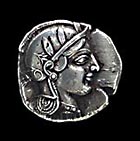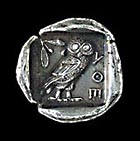The main raw material for jewelry was gold. It came from Asia Minor, Colchis, or Macedonia: there were gold mines on Siphnos, but they had ceased to function by the beginning of the Classical period. The Athenians worked a number of gold mines in the Pangaeum region, also obtaining gold from other sources by trading. Their silver requirements were for a long time met by the output from Laurium. No gold or silver jewelry has yet been found in Attica to match the silver ring bezel from Epirus: this is certainly due to the special type of burial practices. We must assume, nevertheless, that such jewelry was being made at Athens in Classical times. We can get some idea of the rich jewelry styles of our period from the finds at nearby Eretria, which include elaborate earrings with subjects from mythology; necklaces with pendants (perihapton) in the shape of animal heads; and rings with engraved bezels. |
 |

In the Archaic period, Athens was among the first Hellenic cities to mint coins. By mining silver at Laurion, from the start of the 5th century onwards, she was able to set up a powerful mint, closely linked to her economic and cultural progress. Because the Athenian drachma was used as an international currency and had to be mass-produced, Athenian engravers were unable to reap the benefit of other arts. Throughout the 5th century coins continued to be minted with the Archaic device of Athena Glaucopis, and two particular coin types had to do with the battle of Salamis and the victory of Cimon on the Eurymedon river. There were other strong currencies - at Aegina or at Corinth, for instance - that exhibited the same conservative tendency. In Sicily, by contrast, city-states produced striking coinages thanks to new engraving techniques, with the artist sometimes signing his initials.
 |
 |
In Classical times the mint was in the Agora, between the Enneakrounos and the Panathenaic Way.
|
Not until the end of the 5th century did the Athenians cut their first pieces of gold and the coins that Aristophanes was to call "fool's bronze" - coins with just a coating of silver over a bronze core. They might be of better artistic quality, but they never reached the high standard set by mints in other cities. From the mid-4th century onwards, the Athenian coinage was beginning to gradually lose its leading place, as first Philip II's and then Alexander's silver tetradrachms and gold staters replaced it for international dealing.








